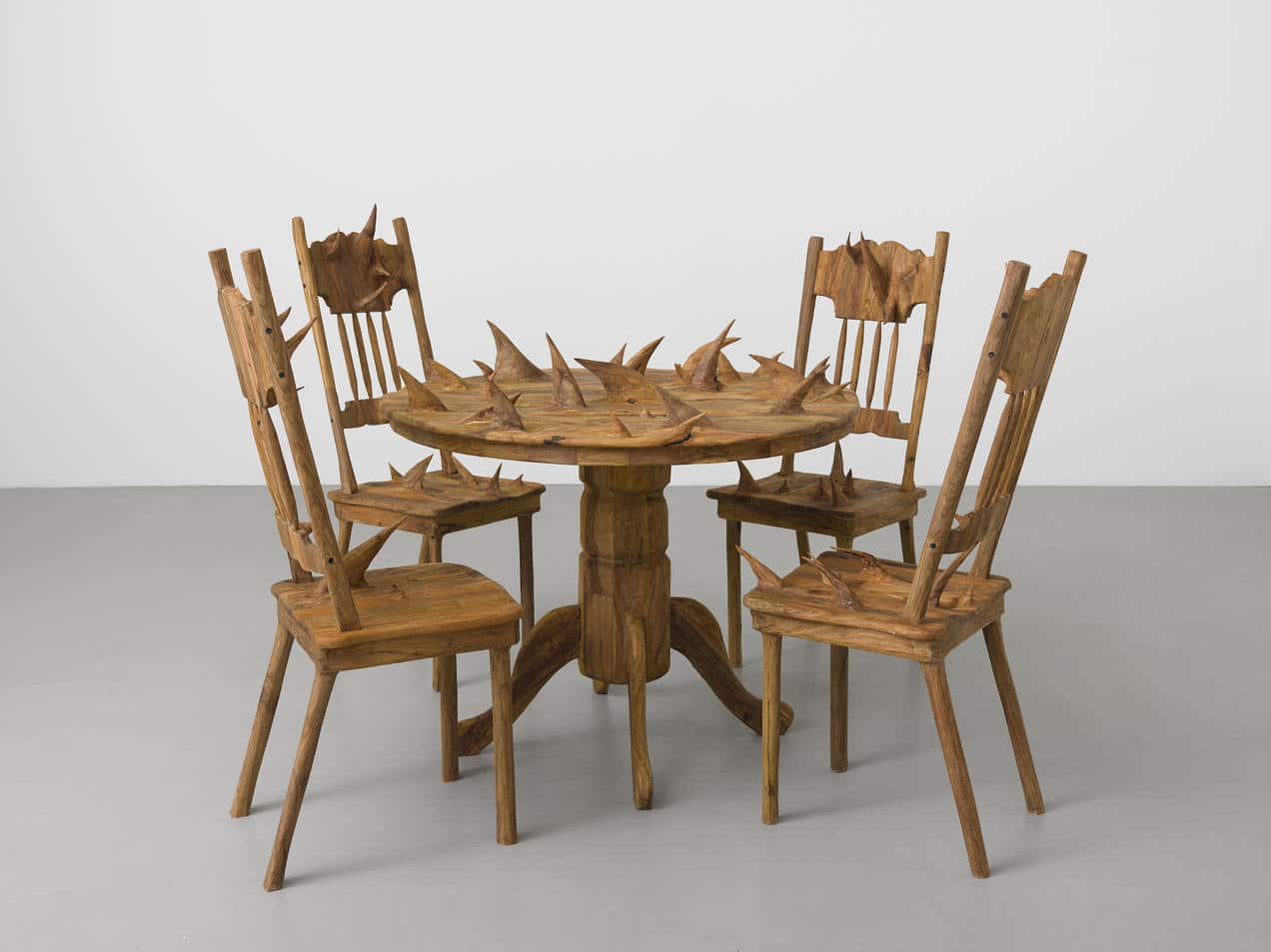

Hedges, 2019 © Hugh Hayden. All photos courtesy of Lisson Gallery
By Patrick Rogers
“I’m really into trees,” said the sculptor Hugh Hayden. “I’m drawn to plants.”
Nature and plants have always been a source of fascination for the artist, who grew up near a protected greenway on the outskirts of Dallas. “My family was always outdoors, not in the sense of camping, but of gardening,” he recalled fondly. “When I was in high school, I was the youngest person in the North Texas Water Garden Society — I was, like, 15, and most of the people were over 55.”
Now working out of a studio in the Bronx, Hayden uses elements of nature to powerful effect in sculptures that have grabbed the attention of curators in the U.S. and Europe. And he recently won a major commission at New York City’s newest cultural outpost, The Shed. Housed in a large exhibition space, Hayden’s Hedges installation presents an architecturally accurate facade of a single classic American suburban home that, thanks to mirrors mounted on opposing gallery walls, is amplified into infinity to form the illusion of an entire street.

Hedges, 2019 © Hugh Hayden
Those illusory houses and their imaginary middle-class occupants, however, are not alone. Sprouting from holes in the walls is a thicket of bare tree branches that appear to colonize the living space. When seen in the mirrors, they form what looks like the world’s longest hedgerow.

© Hugh Hayden
There’s an obvious tension in Hedges between human civilization and untamable wilderness. But Hayden, whose art tends to challenge perceptions of social order and the environment, is also interested in how people use nature as a form of camouflage to mask their differences in order to become part of their communities. “It’s the idea of home ownership and being part of the American dream, of having a little house with its own yard — of blending into a landscape that is also a social landscape,” he said.
Hayden mostly uses salvaged wood that he manipulates through carving and juxtaposition. The branches used in Hedges came from a display of Christmas trees that once stood in the median strip of Park Avenue in Manhattan — one of the nation’s most pedigreed addresses, he notes — which lends his work an aspirational quality. And due to the mirrors placed around them, viewers cannot avoid encountering their own reflections. The artist said, “They’re seeing themselves reproduced in something that is a fantasy. They see how they fit into that American dream.”

America, 2018 © Hugh Hayden
Hayden, who trained as an architect at Cornell and quit his day job designing in the hospitality industry last year to pursue art full time, has been finding great meaning in the trees that he uses as raw material for his sculptures. In 2018 he traveled to the U.S.–Mexico border and gathered branches of mesquite, a tree that many Texans regard as an undesirable invasive species. “Mesquite trees thrive where other trees can’t, on limited resources like water. Given the issue on the border around immigration, I thought of the material as politically charged.” Hayden used the thick branches in a sculpture titled America, which takes the form of a kitchen table and chairs, a classic symbol of welcoming and comfort, but with sharp protuberances that discourage gathering.
On the same Texas trip, the artist paired up with a crew of nursery scouts who buy slow-growing desert palmettos from landowners in the region and then resell them for a profit to wealthy urbanites in Houston. Together they located stands of so-called Texas ebony trees, which have a narrow range of growth in the southern part of the state and in northeastern Mexico. Hayden used the dark brown and blackish wood of the trees’ interior in a pair of meticulously rendered sculptures that comment self-reflectively on the experience of young African-American men.
“To me, that species was like my own identity as a tree,” he said. One piece, Crown of Thorns, which was exhibited at Art Basel in Miami Beach last year, was in the shape of a football helmet, with a knot of thorns inside that render it impossible to wear. The other, Oreo, shown at New York’s Lisson Gallery, represented a baby’s crib also studded with sharp thorns. “I was interested in positioning the imposed expectations of a black man in Texas. I hated playing football, for example, but it was the expectation that I play.” As for the crib, its construction brings to mind the neoclassical architecture of a typical Texas courthouse, where, because of systemic injustices, an African-American man is likely to turn up during the course of his youth.

Oreo, 2018 © Hugh Hayden
“I think people could interpret my work as an ad for a group like Greenpeace,” Hayden said when asked if he considers himself a part of the environmental movement. “Of course, I am for the environment. But I would say my use of natural material is more an extension of my personal interests,” he explained. “I like plants, and I like the idea that I can use something as ubiquitous as trees to change the way that people think.”
Hedges is on view at The Shed in New York City until August 25.

Crown of Thorns, 2018 © Hugh Hayden
Reposted with permission from our media associate onEarth.

 233k
233k  41k
41k  Subscribe
Subscribe 